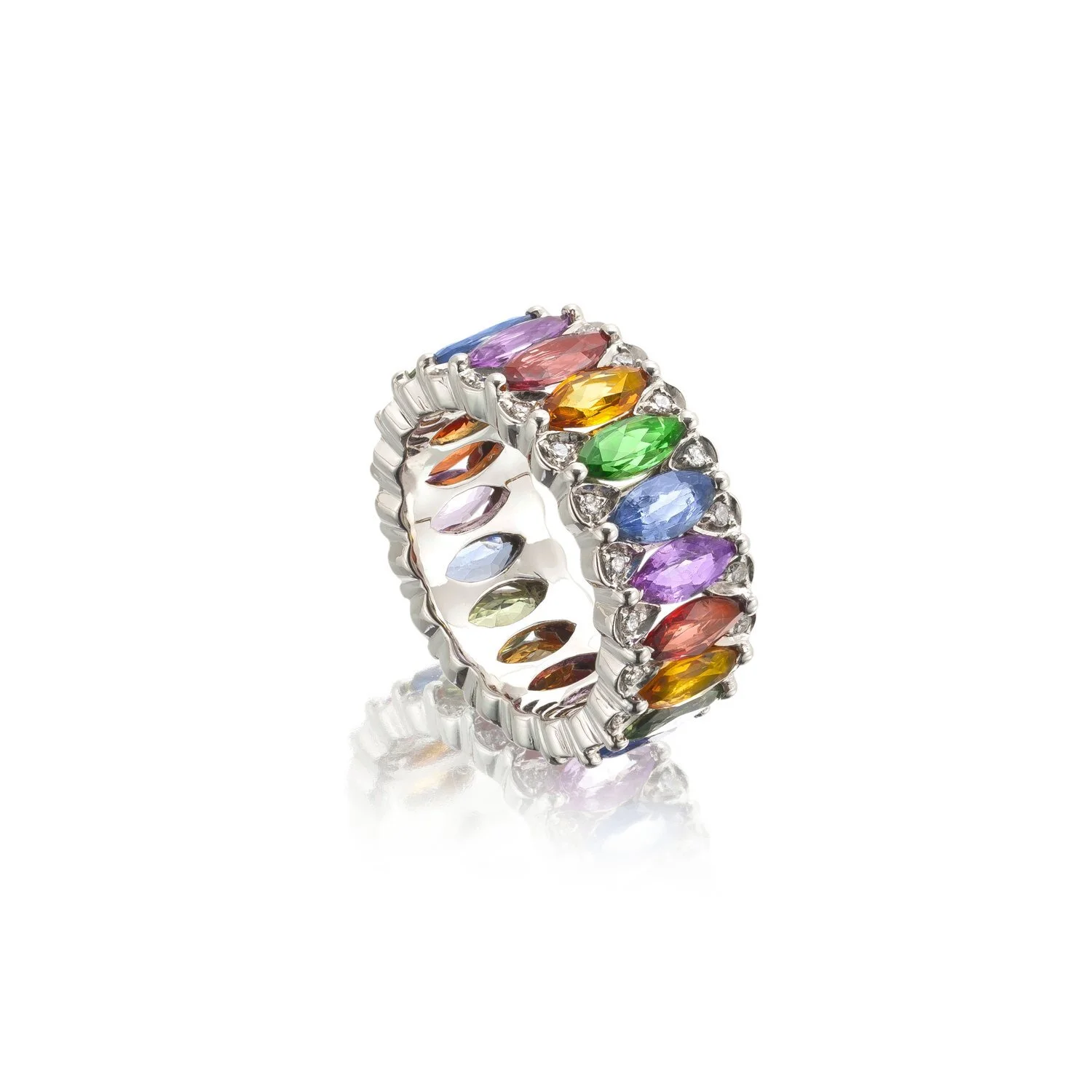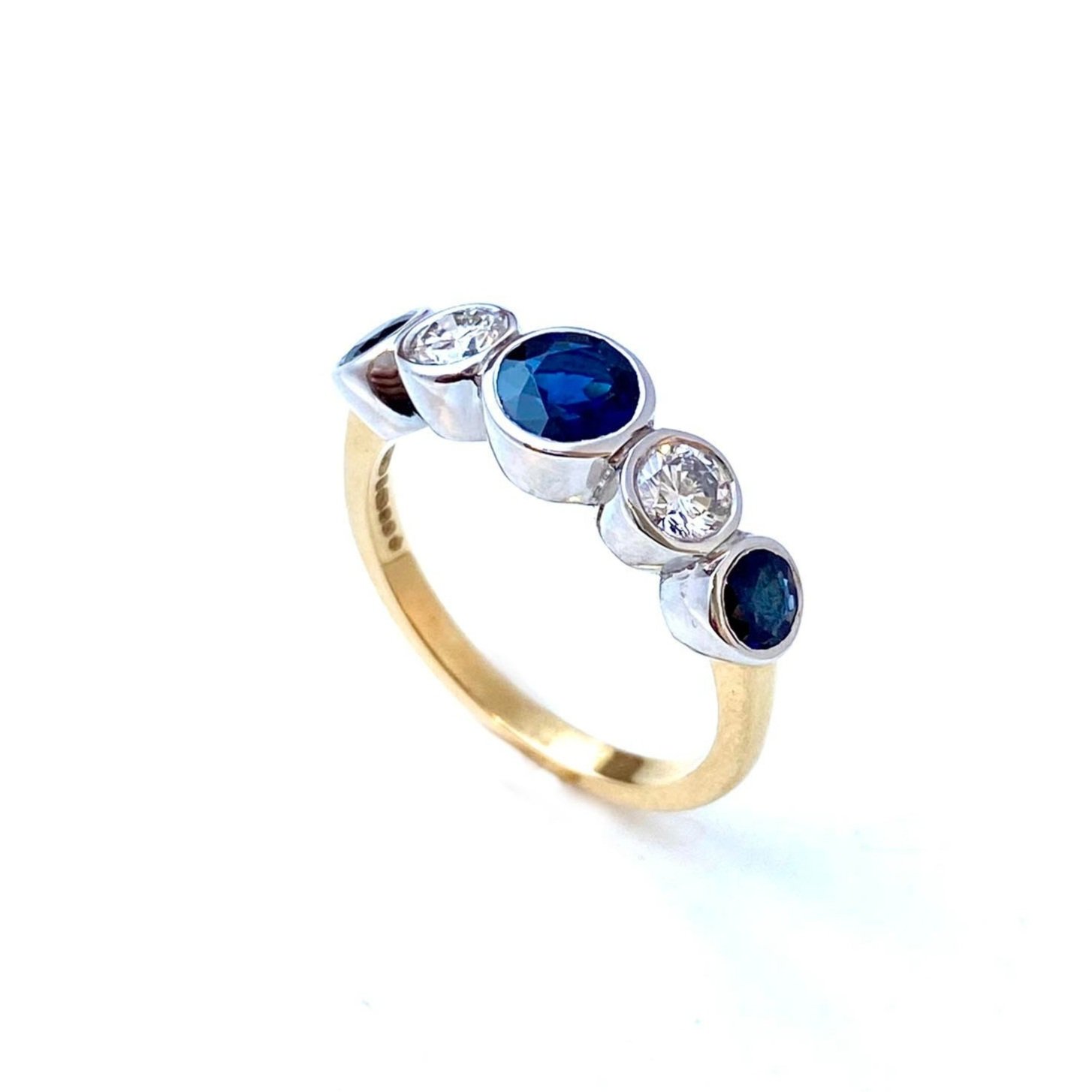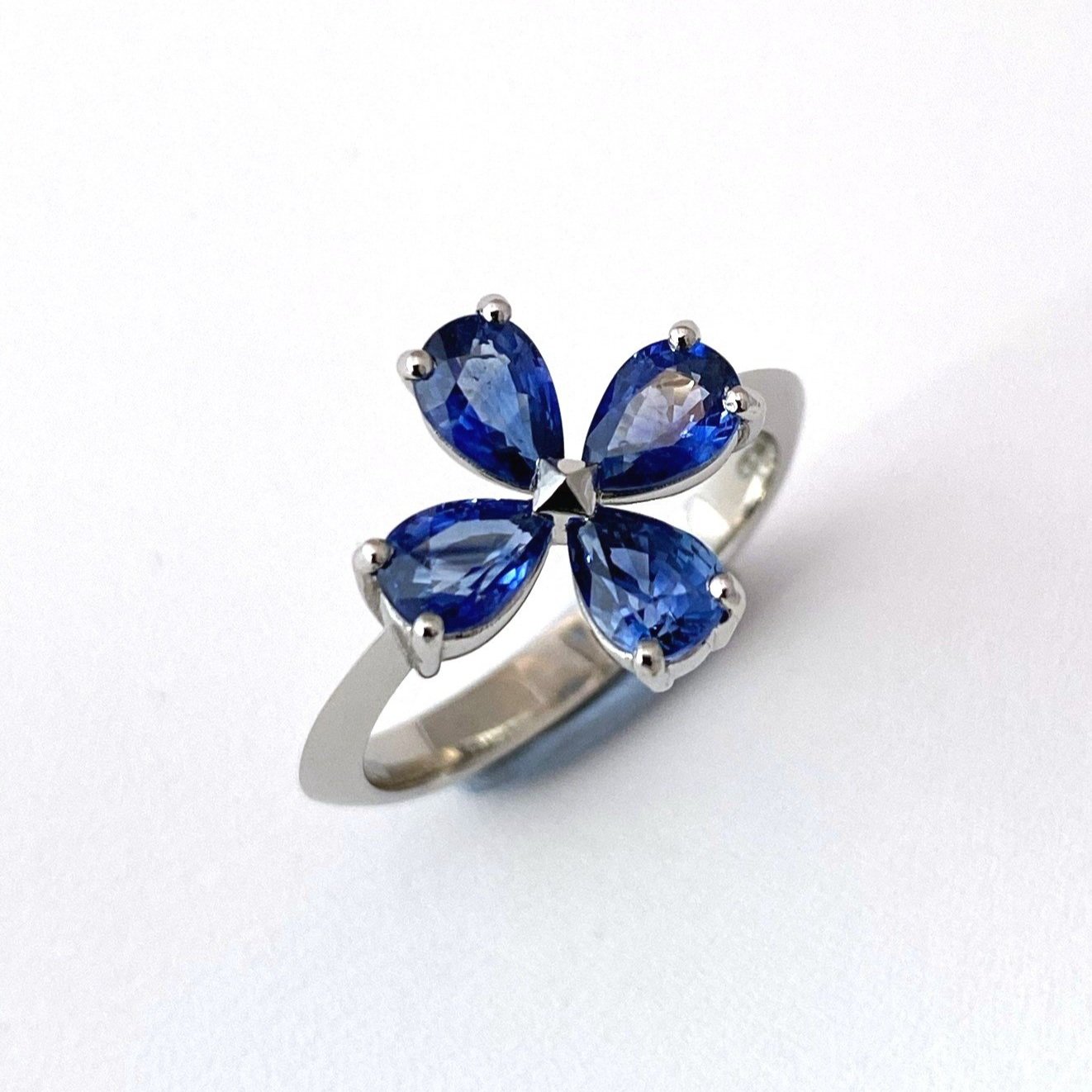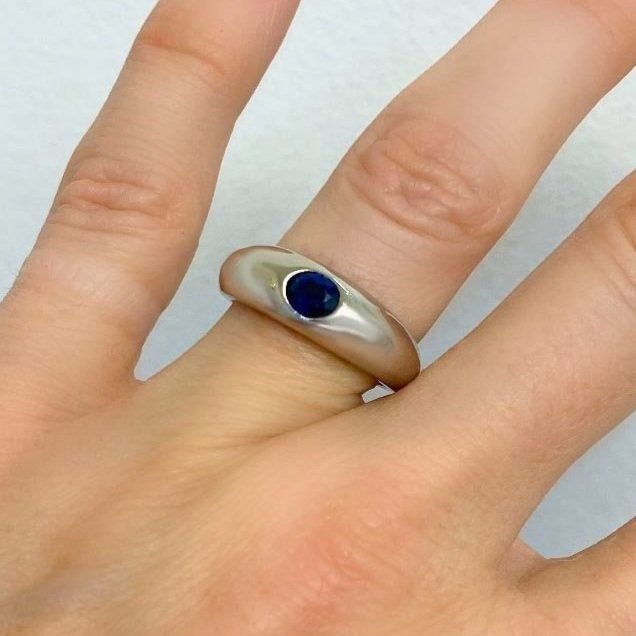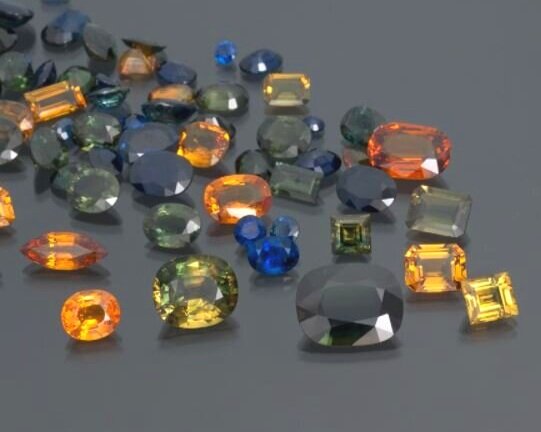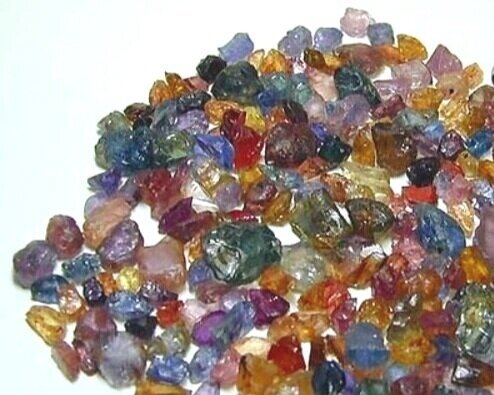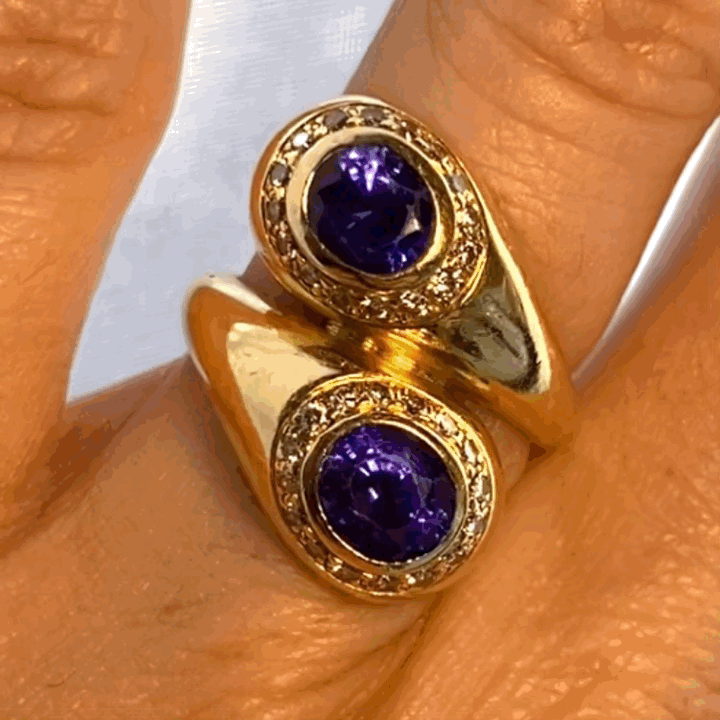All about Sapphire - September’s Birthstone

Stories of the blues (and pinks, yellows, oranges…)
Sapphires are the most popular coloured gems that my customers buy, and just after diamonds, second choice for engagement rings. Along with diamond, ruby, and emerald, the precious gems in the top tier ‘big four’, sapphires catch our eyes and hearts with their dreamy hues and endless sparkly shades.
Sapphire colour
You know that sapphires are not only blue. There’s a sapphire for everyone from a kaleidoscope of yellow, salmon, orange, green, pink, violet, white, black and even star spangled.
Colour in sapphires is caused by minute amounts of metal chromophores, atoms of elements present in the parent rock where the sapphire crystals formed, that give the growing gem its colour, without which it would just be white or colourless. Iron gives yellow, inky blue and green. Add a touch of titanium to iron and you get blue. Add touch of chromium to iron and titanium and you get purple. Take away the iron and titanium and just leave a teensy amount of chromium, and you’re left with pink. Adding more chromium turns the pink to red and that’s when the name sapphire switches to ruby. A multitude of micro-inclusions cause brown or black.
To prove the point, here’s a jewel from The Late Queen’s collection – the Sri Lankan Navaratna Brooch presented by the Mayor of Colombo to The Late Queen on a visit to this Commonwealth nation in 1981. Throughout the last 2,000 years, Sri Lanka has been the richest source of sapphires of many colours. The word navaratna means 'nine gems' in Sanskrit, but (excluding the calibre cut rubies) this actually has 15 single stones all famed for their occurrence in the country and not all of them are sapphires... can you tell which ones are the sapphires (blue, pink & yellow) and which ones are the moonstone, garnet, amethyst, catseye and aquamarine?
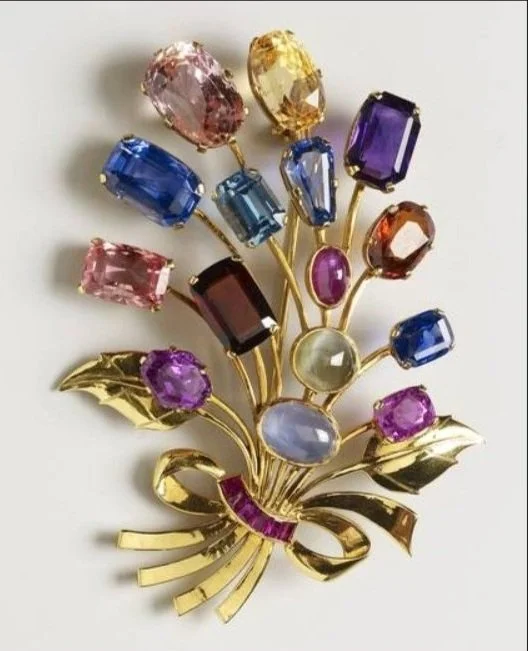
The Late Queen’s Navaratna brooch
Royal Sapphires
The Hesse Brooch

At the deeply moving state funeral of Her Late Majesty Queen Elizabeth II, one of the glittering objects which caught my eye was a spectacular brooch worn by The Queen Consort, Camilla, featuring large drop cabochon sapphires and diamonds. Afterwards, social media went mad for this brooch. Apparently, it is the Hesse Diamond brooch: a gift to Queen Victoria in 1897 to celebrate 60 years on the throne, and the heart-shape frames the number 60 in diamonds.
Wait - the number 60? I don’t see the number 60. What could they mean? I did some more research. This gift for her Diamond Jubilee was given by Queen Victoria’s grandchildren by her daughter Princess Alice, Grand Duchess of Hesse, some of whom were married to members of the Russian imperial family. The number is in Cyrillic! As it was part of her private family jewel collection, The Late Queen gave the brooch to Camilla a little while after her marriage to King Charles in 2005. The Queen Consort has worn this brooch several times since then, but I feel it was a significant and sentimental brooch for such an important occasion.
Queen Elizabeth’s Cartier sapphire bracelet
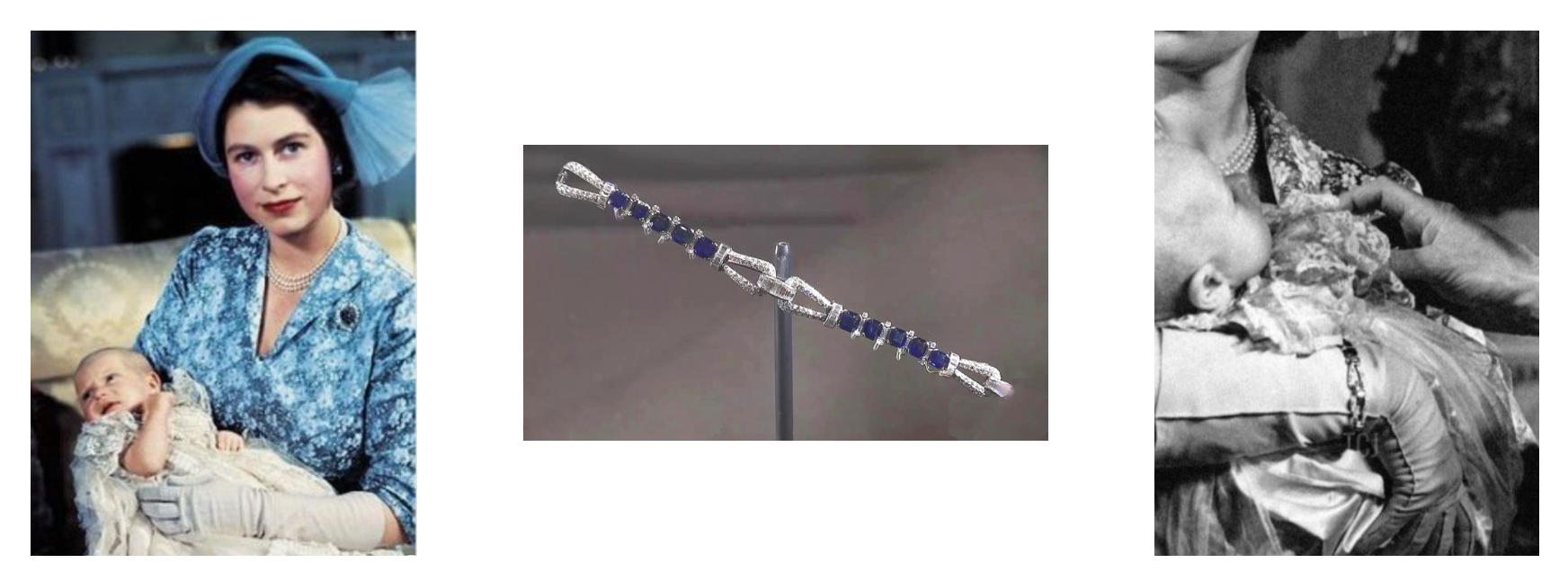
Our Late Queen Elizabeth loved jewelery and wore it famously well, both as an accoutrement of her role and status, and for its sentiment. Sapphires were one of her favourite gems - one of her first ‘proper’ pieces of jewellery was an elegant Cartier sapphire and diamond bracelet (made around 1920) given by her beloved father George VI for her 18st birthday. She wore this piece often as she actually had very few jewels until her Accession. This very personal piece was briefly displayed, with a select few others rarely on display for a special Platinum Jubilee exhibition at Buckingham Palace, which closed early due to her sad death.
My Sapphire Sketch Book
Let me share some stories of sapphires I’ve had the pleasure of working with recently.
|
Put the sparkle backDo you sometimes wish that the thing you love most could be made just a little bit ‘newer’? This much-loved engagement ring came to me for some TLC. By carefully repolishing the crown facets of the three sapphires and setting everything into a new, contemporary style ring mount, I was able to give it a new lease of life and a style boost.
Madagascar Sapphire engagement ringThis spectacular cornflower blue sapphire is from Madagascar, where the finest gem blue sapphires have come from in the last few years. This ring is for a couple who had thought carefully about what they wanted and knew just what they dreamed of - a rare, natural, unheated sapphire set with pear shape diamonds in an elegant hand-crafted ring. Sapphires this perfect are hard to find, but I found their ideal gem via my international network. When this couple started their search for an engagement ring, the world was a different place. Then Covid-19 hit, the world stood still, and they shelved their sapphire dreams for a few anxious months. However, as soon as they felt more confident, I tracked down ‘their’ sapphire again, and their romantic ring finally became glittering reality.
|
Bespoke Sapphire Petals ringI recently designed a bespoke ring for a client who wanted something as unique and beautiful as his gorgeous daughter. It is an amazing 21st birthday gift, a special design that is grown-up but vibrant, unusual but wearable, a cocktail ring that could just as easily be taken for picnic lunches. She is a talented dancer with a kind, wise spirit. She selected this design like a garland of petals and we chose classic cornflower blue sapphires from Sri Lanka, the magical island of gems that, like Madagascar, produce most of the prettiest blues on the market. It’s important to me that gemstones have a happy beginning as they come through the market and into my customers’ lives, and Sri Lanka has a centuries old and respected gem mining ethic.
Family Sapphire Ring remodelledAnd this is a very special sapphire. It comes originally from my client's late mother's ring. I reused it for a new bespoke gypsy ring for her elder daughter's 21st birthday. It’s a 3rd generation gemstone: an heirloom from one of her grandmother’s rings, and it is a talisman of love and constancy - sapphire is the traditional symbol of both sentiments. A ring is symbolic of unity, in this case of her family’s love and support. This young lady is a born traveller, studying abroad from an early age and unafraid to explore all that the world has to offer. I love that the gipsy ring design chosen by her mum represents her urge to go, live and do, so well. All in all, this is a perfect gift to express a powerful prayer of love and protection through life’s journey. |
Sapphire Facts
Where do sapphires come from?
Sapphires are formed around the world in areas of tectonic activity during mountain building. Globally, the most commercially well-known sources are Sri Lanka, Kashmir, Thailand, Palin, Australia, Montana and more recently, the African nations of Tanzania, Kenya and Madagascar, Nigeria, Mozambique, Cameroon and Malawi. Sapphires have even been found in the Outer Hebrides Island of Lewis. Historical sapphires used in European jewels were sourced from trading sources known at the time mainly Sri Lanka but also the Massif Central, France.
For centuries, Sri Lanka has been a major supplier of gem sapphires. The Sri Lankan government seek to support as many individuals as possible, not to develop a global market held in international hands, and importantly to limit the environmental impact on their beautiful island as a result. When exhausted, the small mines are back-filled with tailings and quickly reclaimed as rice fields. Only 10 out of 6,500 mining licences are awarded to large scale mechanised (LSM) operators; mines are small, mostly privately owned and family run operations. It’s a well regulated and important economic sector, and miners take pride in their hard work, skill and know how.
In contrast, for the last 20 years, Madagascar has been the source of some of the most beautiful new blue sapphire coming into the trade: so good in fact, that at first they were mistaken as Kashmiri. Today 40% of all sapphires come from Madagascar, but few are actually cut and polished there, and this needs to be remedied via more investment and training.

Main global sources of sapphire
How are sapphires mined?
Sapphires, like all coloured gems, are very hard to find in significant volume. Unlike gold and diamonds, which are industrially mined, 80% off the sapphires in the world come from rural areas in low-income nations, where there's land for farming and informal gem mining but few other resources. Most sapphires and other gems are found in ‘gem gravels’ - where Mother Nature has done the hard work over countless millions of years by eroding the durable gem crystals out of their host rocks. Gem gravels lie in the beds of ancient rivers which were later covered by layers of mud and soil. It’s possible to dig down to find these seams, and mines are dug in the dry season when there's no farming possible, down to about 3 metres deep. When the mines are depleted, they are back-filled with the tailings, so that the old pits do not harm livestock or impact future crop farming. Buckets bring the gravels to the surface, where they are sieved and washed through by hand or by generator-operated jiggers, with eagle eyes quick to pick out anything of value.
Commercial, large-scale sapphire mines are few and far between because of sapphire’s relatively low market value to the return on investment in heavy machinery in locations where the gems are still embedded in their host rock in sufficient quantity to make the cost viable. A recently built industrial sapphire mine in Greenland unearths pink sapphires and rubies from deep within 3 billion year old rock, bringing employment and skills to one of the most isolated regions of the world. And industrial sapphire mining in Australia may be rekindled decades after halting, as a recent exploration survey has shown work may once again be viable. However, both these operations are miniscule in comparison to a diamond mine.
Ethical sapphires
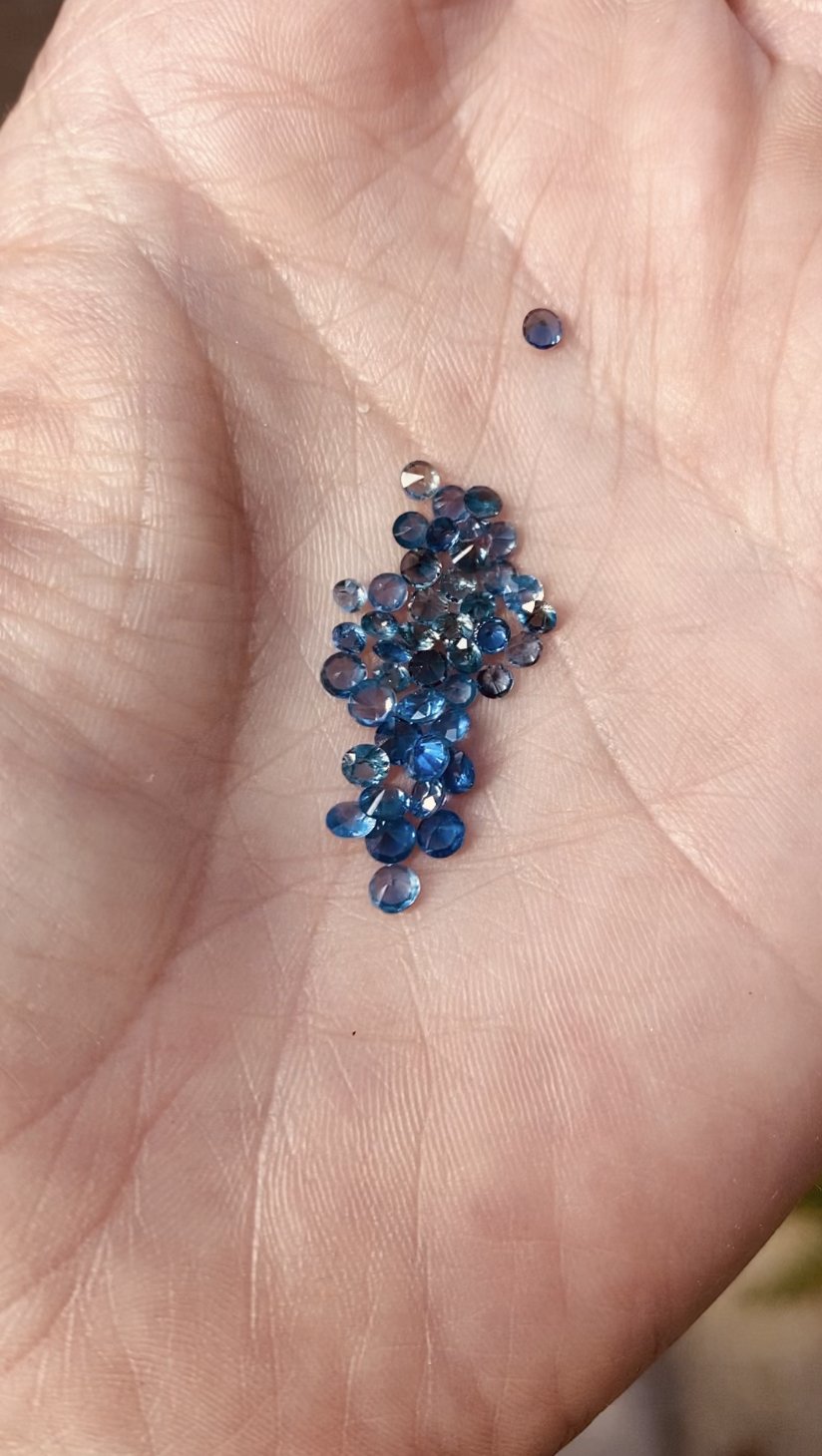
My new collection features the prettiest sapphires from Madagascar
It’s worth knowing more about mining and its human impact, as it’s part of the whole story of your pieces. I’m interested in supporting the individuals and small enterprises that form the mass of the jewellery industry, so when I was searching for sources for sapphires for my new jewellery collection (coming soon!) I was thrilled to find a Euro-Malagasy business. They are a small mines-to-market business who have lifelong relationships with the country. I love it that they pay the miners a fair market rate for the rough gems directly. They ensure miners are funded and have the proper safety equipment they need. They support the cutting and polishing skills necessary to process the gems within the nation, without losing out on skills development due to the uncut rough gems being exported to the major markets in Sri Lanka and Bangkok instead.
What’s the origin of the name sapphire?
The Greeks were the first to write down classes of mineral types and their descriptions. Like many other gems, sapphires owe their beautiful name to Ancient Greek scholars who used the name sappheiros to describe all bright blue gems.
Sapphire Gemmology
Sapphire is the precious gem variety of the mineral corundum which occurs in various colours, but red corundum is called ruby. All are formed from atoms of alumina bonded with oxygen, amongst the first elements formed in the Universe. The atoms form such a tight bond that all sapphires (and rubies) are incredibly tough and resistant to scratches, wear and tear. They are ideal gems for everyday – good news for us jewel lovers.
Fun fact - nano sapphires and rubies sparkle in giant clouds of star dust and nebulae in the heavens.
How do sapphires form?
Basalt and Metamorphic types
There are two formational types of sapphire. Firstly, basaltic origins cause the inky blue-green-yellow coloured sapphires, coloured mainly by tiny amounts of iron, from areas where lava flows have pushed into gaps as tectonic plates rift the Earth’s crust apart. The second type is metamorphic, where stunning blues, rainbow yellows, peaches, pinks and violets come from areas where mountain building processes have pressure cooked two parent rocks formed from a ‘witches brew’ containing the exotic colouring elements titanium and chromium. Hot fluids circulating at the contact zones of these two parent rocks leach out the minerals that create new sapphire crystals.
Basaltic Blue Green Yellow sapphires, image Lotus Gemology
Basalt sapphires - blue-green-yellow sapphires
Sapphires are relatively widespread because Earth’s tectonic processes have shifted and moulded its entire surface over hundreds of millions of years. The inky blue-green-yellow sapphires, coloured mainly by iron, come from areas where basaltic lava flows have bubbled up rifting the Earth’s crust apart - Eastern Australia hosts a vast swathe of such basaltic sapphires and until around 1980-90 was the world’s major producer of gems along with Thailand. But high iron sapphires come from all corners of the Earth: far north Madagascar, Montana, Nigeria, Massif Central France, there’s even a tiny dyke of basalt that produced a chunk of sapphire on the Isle of Lewis in the Scottish Hebrides.
Rough sapphires Umba Valley, image IGS
Metamorphic sapphires - multi-colours
The rainbow colours - cornflower blues, yellows, purples, pinks - come from metamorphic areas where mountain building processes have pressure cooked a ‘witches brew’, containing lower iron values but with various quantities of titanium and chromium.. The Umba Valley in Tanzania is famous for its rainbow hued sapphires. A metasomatic/metamorphic formation leads to the most desired soft velvety blue of Kashmir, Burma (Myanmar), Sri Lanka and Madagascar - with the highest price tags.
Heating sapphires
Heating sapphire to improve its appearance is a centuries old technique, with technical innovations leading to high heat treatment common over the last 30-40 years. Many sapphires have inclusion called ‘silk’ which is formed of fine microscopic needles of rutile - titanium oxide. By heating the gem, titanium in the silk is diffused which improves the blue colour, often spectacularly. Large quantities of milky coloured sapphires found in abundance in Sri Lanka are heated and the advantage of this is that beautiful blue sapphire jewellery is available to more people at an affordable price, and that’s fine so long as heat treatment is always disclosed. Heat treatment is discerned by experts examining the tell tale appearance of minute inclusions inside the gem. A sapphire with no heat treatment is comparatively rare and commands a much higher price, often double.
Sapphire meaning
Blue symbolises spirit, the heavens, true love and fidelity. Its symbolism extends to religious expression for eternal love from Buddhism to the Virgin Mary.
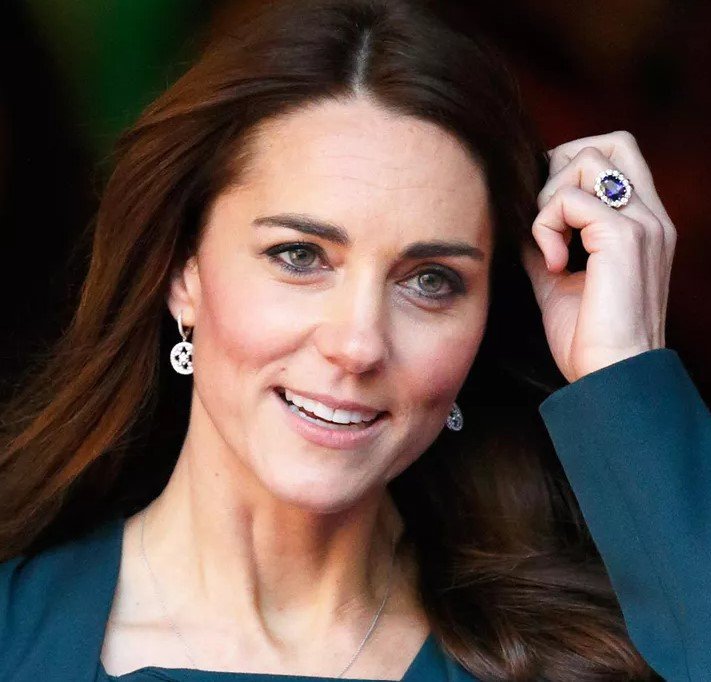
Sapphire wedding day - ‘Something Blue’
Because of its meaning of true love and constancy, blue is a lucky colour for marriage - the ‘something blue’ - hence its popularity for engagement rings most famously the engagement ring owned by Princess Diana, now worn by The Princess of Wales. Kate Middleton Duchess of Cambridge
Sapphire anniversary
45 years is a long time, and as sapphire symbolises faithfulness and blue means true love, what more apt gem to celebrate a 45th anniversary?
Sapphire birthstone
Today the West attributes sapphire to Virgo and the month of September - apt considering Virgo’s famous traits of faithfulness and sapphire being a symbol of constancy. But birthstones are attributed to various calendar months, zodiac signs and planets by different schools of thought and tradition, and they have changed through history. In Ayurvedic traditions, sapphire represents the planet Saturn which symbolises discipline and the spiritual life. A hundred years ago, the American gemmologist George Frederick Kunz stated that sapphire was April’s birthstone, and in historic Spanish traditions the gem was linked to Taurus and Gemini.
Sapphire value
Anyone can own a sapphire: there is a lovely stone for any budget from a few pounds up to millions. Value is judged on the quality of colour, clarity and absence of internal flaws, size and cut, and whether the gem has been heat treated. The better any of these, the more valuable the stone. Add in provenance or origin, plus an inspection report from a respected gem laboratory, and prices increase accordingly.
The most desirable sapphires are held to be from Kashmir or Myanmar and are the intense, shimmering royal or cornflower blue of a peacock’s feather. Expect to pay up to $250,000 per carat for a fine large stone of 20ct plus, and to compete with the world’s elite for the pleasure of owning one.
If you visit a high end jeweller, you’ll maybe see fine stones with a No Heat laboratory report from the more well-known countries of origin such as Myanmar, Sri Lanka and Madagascar in a desirable size of 1.5 - 2.5 carat weight that cost in the region of $4-6,000 per carat. The value of these stones has been stable at around this level for a decade.
The most popular cuts are facetted ovals and cushion shapes, and skilled cutters will ensure that the part of the gem with the richest colour saturation will be in the culet - the deep pointy back end of the stone - so that the gem ‘faces up’ well and the colour is reflected internally around the stone. Most sapphires have their colour in stripy zones because of the changing amounts of colouring elements available as the crystal grew. Paler areas are called ‘windows’, so a good gem will be one where colour zoning isn’t much apparent when it’s in its setting.

A graded scale of blue sapphire value - best quality from left to less valuable on right (source Gem-a)
Some gems are cut as domed cabochons, and these stones weigh more than the equivalent faceted sizes. The cabochon cut is best for larger less expensive stones in mid to-light tones, which means that their value and appeal is better as a cabochon, than as a large faceted stone that’s considered on the pale side.
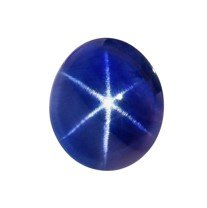
Very fine gem quality star sapphire cut as a cabochon
Star sapphires
Sapphires, like ruby, can contain microscopic needles of intersecting rutile which cause a beautiful optical effect seen with strong beam of light. A white star dances across the surface of the stone – these are called ‘star sapphires’ and are among nature’s most beautiful secrets. Frequently they are a pale blue, but a rarer darker blue colour will cost top dollar. To see this effect, the gem must be cut as a cabochon - with a domed surface, rather than being cut and facetted.
The largest sapphire in the world
The largest gem sapphire is the Blue Giant of the Orient, a 486.52ct found in 1907, and sold for $1m in 2004. The second largest is the Logan Sapphire 422.99ct from Sri Lanka.
The largest star sapphire recorded is the 1,404.49ct Star of Adam - a sky blue Sri Lankan stone with a bright star which is as big as a man’s palm.
The most expensive sapphire ever
The record price for a Kashmir sapphire is $242,000 per carate for 27.68ct octagonal sapphire Jewel of Kashmir, Sotheby’s Hong Kong 7 Oct 2015 ($6.7m) incl 3 lab reports Gubelin, SSEF or AGL.
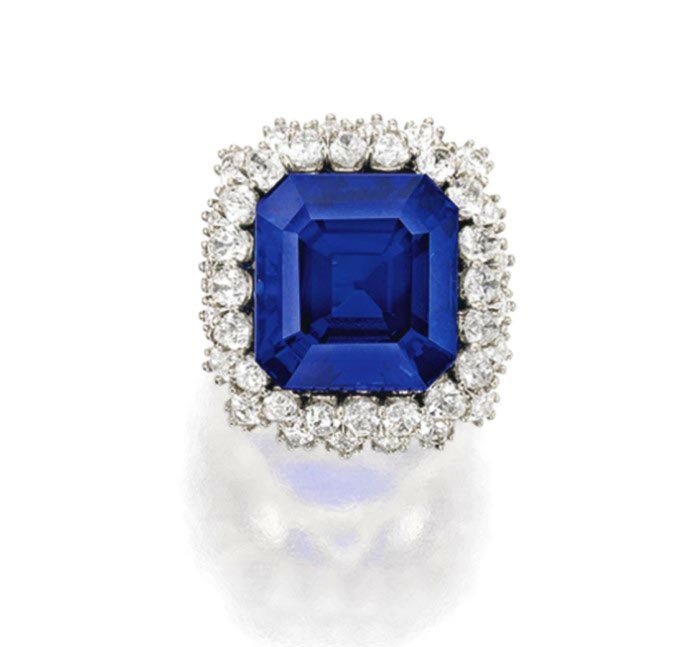
The Jewel of Kashmir sapphire 27.68ct $242,000 per carat
In at a close second is the more than $200,000 per carat for a 35.09ct cushion shape ring sold at Christies Geneva in 2015.
And finally….
Colour-change Sapphires
Not everyone knows this, but some sapphires change colour.
As a gemmologist, I get such a kick out of these tricks of nature. I was shown this pair of sapphires by a dealer a while ago and I just had to buy them – how could I resist? The colour change depends on the source of light: in bluish sunlight they are cornflower blue but in yellowish electric light they switch to violet purple. This fancy effect is due to four metallic chromophores being present in the geological ‘broth’ while the crystals grew - iron, titanium, vanadium and chromium - a rare and unusual occurrence, even for the freakishly rare conditions that give birth to gems in the first place. I did think about having them as a pair of earrings, but then I wouldn’t be able to enjoy watching the colour change. So I designed myself this cross-over ring, which I love to wear almost every day.
My colour change sapphire cross-over ring


